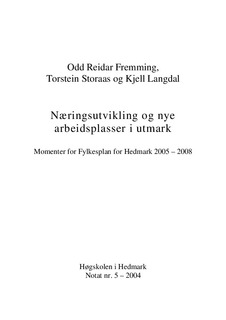| dc.contributor.author | Fremming, Odd Reidar | |
| dc.contributor.author | Storaas, Torstein | |
| dc.contributor.author | Langdal, Kjell | |
| dc.date.accessioned | 2012-05-08T11:16:04Z | |
| dc.date.available | 2012-05-08T11:16:04Z | |
| dc.date.issued | 2004 | |
| dc.identifier.isbn | 82-7671-409-9 | |
| dc.identifier.issn | 1501-8555 | |
| dc.identifier.uri | http://hdl.handle.net/11250/133516 | |
| dc.description.abstract | Utmarka er områdene som ligger utenfor innmark og bosettingsområder.
Utmarka kan brukes til å:
1. Produsere og høste salgbare produkter som tømmer, kjøtt og bioenergi.
2. Trekke til seg turister og hyttefolk som oppsøker verdiene i utmarka for
rekreasjon.
3. Trekke til seg folk som tar med seg arbeidsplassene for bosetting i distriktet for
å nyte utmarksverdiene.
Omsetningen rundt opplevelser i utmark (særlig hyttenæringa) har i dag vokst til
samme størrelsesorden som produksjonen av salgbare produkt. Skogbruket er en
moden næring der tallet på sysselsatte trolig har stabilisert seg. Det kan være et lite
potensiale i ved og bioenergi. Med mindre importvern og mer rovdyr vil tradisjonell
beitebruk bli ulønnsomt, særlig i sørlige Hedmark. Elg vil kunne bruke de frigjorte
beiteressursene. Viltet kaster mindre av seg i områder med faste stammer av ulv.
Styresmaktene vil kunne godtgjøre dette tapet der styresmaktene bestemmer at det skal
være ulv. Med mer kunnskap og landbruksmessig forvaltning vil inntektene fra vilt og
fisk øke. Det vil likevel trolig være få arbeidsplasser innen vilt- og fiskeforvaltning.
Taigaen begynner ved Ånestadkrysset (Rolf Jacobsen). Største verdien av utmarka kan
være illusjonen om taiga og kulturen knytta til den naturlige bruken av den. Ved
målretta utmarksforvaltning kan denne illusjonen bygges sterk og trekke turister,
friluftslivsutøvere, hyttekjøpere og fastboende til Hedmark. | no_NO |
| dc.description.abstract | English: The Norwegian word utmark is a name for the wildland with forests or
alpine areas outside settlements and cultivated land. The utmark may be used to:
1. Produce and harvest commercial products like timber, meat and bioenergy.
2. Attract tourists and cabin owners that seek the values in the utmark for
recreation.
3. Attract people that take their work to settle in the district to enjoy the values of
the utmark.
The economic gross value of recreation in utmark (especially the cabin industry) has
recently increased to the same order of magnitude as the production of commercial
products. Forestry is a mature industry where the number of employees may have
almost stabilized. There may be a potential increase in production of firewood and
bioenergy together with the need for forest establishing (planting) and brush clearing
in young stands. With less trade protection and more carnivores traditional grazing in
utmark will become unprofitable, especially in southern Hedmark. Moose may use the
released grazing resources. Wildlife will be less profitable in areas with permanent
wolf packs. The Government may compensate for these losses where local people are
not allowed to remove the wolf. With more knowledge and agricultural management
the income from wildlife and fish may increase. However, there will probably
continue to be few jobs in wildlife and freshwater fish management. The poet Rolf
Jacobsen wrote “The taiga starts at the Ånestad junction” (close to the regional capital
Hamar). The greatest value of the utmark may be the mental image of the taiga as a
concept, and the culture of the traditional use of it. With directed management this
image may become strong and attract tourists, recreational users, new cabin owners
and residents to Hedmark. | |
| dc.description.sponsorship | Hedmark Senterparti | no_NO |
| dc.language.iso | nob | no_NO |
| dc.relation.ispartofseries | Høgskolen i Hedmark - Notat;05/2004 | |
| dc.subject | næringsutvikling | no_NO |
| dc.subject | utmark | no_NO |
| dc.subject | Hedmark | no_NO |
| dc.title | Næringsutvikling og nye arbeidsplasser i utmark. Momenter for Fylkesplan for Hedmark 2005 – 2008 | no_NO |
| dc.title.alternative | Business development and creation of new jobs in the land outside settelment and cultivation. Elements for County Plan for Hedmark | no_NO |
| dc.type | Working paper | no_NO |
| dc.subject.nsi | VDP::Agriculture and fishery disciplines: 900::Agriculture disciplines: 910 | no_NO |
| dc.source.pagenumber | 226 | no_NO |
